 Recently, various groups on social media in Maharashtra, especially Pune, were abuzz with photos of a folded magenta Paithani silk saree, with Kolhapuri jewellery kept on top of it. At first glance, you may not find anything unusual about it. A closer look will reveal that it is actually a cake!
Recently, various groups on social media in Maharashtra, especially Pune, were abuzz with photos of a folded magenta Paithani silk saree, with Kolhapuri jewellery kept on top of it. At first glance, you may not find anything unusual about it. A closer look will reveal that it is actually a cake!
A quick check on Facebook told me that the creator is well within reach! Tanvi Palshikar, a home baker based Kothrud, is the creator of this intricate cake, that is being widely circulated on social media platforms like Facebook and WhatsApp. Palshikar revealed that she had made this cake for one of her trusted clients Ketki Kulkarni Puranik, who wanted a customised cake for her mother-in-law’s birthday.
“A couple of days earlier, we had discussed about her mother-in-law’s fondness for Paithani sarees and we decided to make this cake. She shared some photographs of the saree and some jewelry she likes to wear on it,” said 27-year-old Palshikar, whose home baking venture Cakilicious turned three this month.
 This unique 1.75 kg cake shows a saree neatly folded, with a pallu of golden zari with colourful peacock motifs on the folds. On top of it, a pearl-studded Kolhapuri choker necklace set with a Maharashtrian nose pin (nath) is kept — and it’s all edible and handmade!
This unique 1.75 kg cake shows a saree neatly folded, with a pallu of golden zari with colourful peacock motifs on the folds. On top of it, a pearl-studded Kolhapuri choker necklace set with a Maharashtrian nose pin (nath) is kept — and it’s all edible and handmade!
“It’s a vanilla chocolate chip cake and it was eggless. It took me three hours to bake it and 8 hours to decorate. This type of decoration is called ‘Sugar Craft’. The saree pallu or padar as we call in Marathi, is all hand painted with edible golden paint,” Palshikar said. She has not even used any molds for it.
Palshikar is an interior designer by profession but took to baking after she got married. I can tell from personal experience that it takes a couple of weeks in the kitchen for you to realise the immense potential that awaits many in this business — baking and cooking. I have myself made things I had earlier thought were impossible. So I can totally relate with what Tanvi must have gone through at that time.
With the support of her husband Onil and other family members, she started her own venture. Isn’t that cool… when the family supports you, nothing is impossible.
 She gets 50 customised cake orders in a month, where her endeavour each time is to ‘Bake your imagination’. She admitted that she did not expect it to go viral on Facebook, and is ‘amazed and flattered’.
She gets 50 customised cake orders in a month, where her endeavour each time is to ‘Bake your imagination’. She admitted that she did not expect it to go viral on Facebook, and is ‘amazed and flattered’.
“I had no idea this was happening until I checked my phone two days ago and saw the photo. I have no words to express my happiness! It feels great,” she said.
 I know where my next cake is coming from! You can hunt for Tanvi’s (that’s her in the pic) Cakilicious on the Facebook as she has a dedicated page. The photo gallery will give you a peek into the kind of cakes she has made in the past.
I know where my next cake is coming from! You can hunt for Tanvi’s (that’s her in the pic) Cakilicious on the Facebook as she has a dedicated page. The photo gallery will give you a peek into the kind of cakes she has made in the past.
The above story first appeared in Sakal Times newspaper in Pune.














